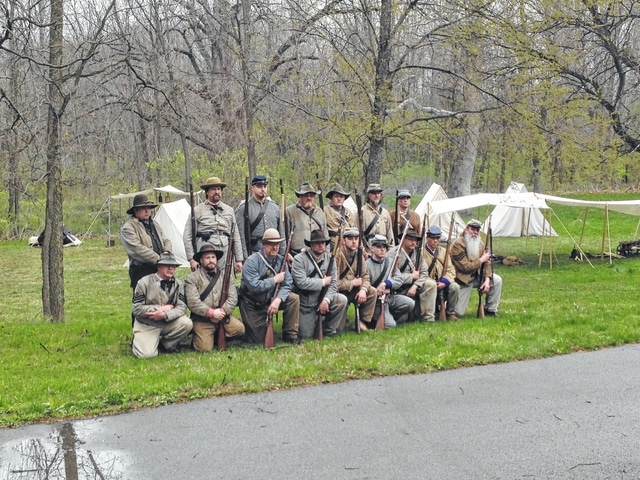
Editor’s note: J.R. Sharp is the captain of Company B of the First Tennessee Infantry Regiment. Company B will be one of the units participating in the Civil War re-enactment scheduled for Sidney Sept. 17-18, 2016. In addition, Captain Sharp will be commanding all Confederate forces during the weekend.
SIDNEY — A common definition of re-enacting is as follows: Historical reenactment is a scripted educational or entertainment activity in which participants follow a prearranged plan to recreate aspects of a historical event or period—often a military engagement or display. This may be as narrow as a specific moment from a battle, such as the reenactment of Pickett’s Charge presented during the Great Reunion of 1913 at Gettysburg, or as broad as an entire period, such as Regency reenactment or The 1920’s Berlin Project.
To many involved in the hobby, the definition itself cannot be quantified into words. Everyone within the hobby comes into it with their own personality and skill set, drawing different needs or desires from the hobby itself. For some, it may be the camaraderie that comes with camp life. For others, it may be the feeling of stepping onto the battlefield and recreating to the best of our ability those moments. In general, the purpose of the hobby is education. Education of not only the public who come to witness the events, but for reenactors it’s a way of educating ourselves in a way that only re-enacting can provide.
When newcomers enter the realm of re-enacting, they are immediately inundated with information and knowledge. General history, authenticity and safety guidelines, group operating procedures and most importantly, drill, lots of drill.
The first rule of thumb for those new to reenacting is to not get intimidated. Everyone in the hobby started from somewhere and we have all experienced the “fish out of water” feeling that most of use have when starting something new. In general, veteran re-enactors assist those new to the hobby providing lasting memories and friendships that transcend the hobby itself.
First, let us look at some of the basic terms involving Civil War re-enacting. There are generally three types of events. The first (and most common) is a battle demonstration or tactical demonstration. These events are loosely scripted to demonstrate what combat was like during the time period portrayed. These are typically open to the public and offer a wide range of experiences. The scenarios depicted may have some inspiration taken from various engagements, but are not meant to fully represent any particular event in history.
The second type of event is a living history event. A living history is in essence a living museum. Groups are encouraged to give talks and demonstrate to the public a number of different things. Typically some re-enactors will develop what is called a “first person impression”, totally adopting the dialect, mannerisms and knowledge of a particular person in the time period. These do not normally have any battle scenario planned, but rather drill demonstrations and the like.
The third type of event is a historical re-enactment. These events attempt to portray historical battles with as much accuracy as possible. Many times, these are reserved for “anniversary” events, such as the 150th Gettysburg. In these, events are strongly scripted to recreate the actual maneuvers and events that took place in the particular battle.
Within historical re-enactments, there are several types, one of which is a “tactical”. Tacticals are a very rare sort of event and are done for the entertainment of the re-enactor as opposed to the spectator. These are a free form event where only an objective and rule set are given. Units are then allowed to use their knowledge of 1860’s drill to accomplish their goals.
Re-enactors also share common terminology. Impression is what re-enactors portray at an event. An impression may be generic or detailed, depending on many things. Most only portray a generic impression and work from there.
A farb is one whose uniform is not up to snuff. Modern fasteners and materials are used, hats, shoes and other items are generally not correct. These could be individuals just starting out in the hobby with a very shallow knowledge base as to what is right. Re-enactors strive for authenticity.
Mainstream are re-enactors that have acceptable uniforms and drill, but it essentially stops there. There is only a loose effort for authenticity in camps and small attempts to disguise modern items.
Most re-enactors fit into the progressive category. The re-enacting world views these individuals as doing everything they can to portray things correctly. Modern items in camp are hidden, uniform and drill standards are maintained to a high level. Most groups in the area fit into this category.
Authentic is the last “caste” of re-enactors. Authentic is more of a lifestyle. These individuals typically camp, eat and do everything in the manner in which they were performed in 1860. Observers would never find cell phones or fast food in camp!
Of the four classes outlined above, members of the 1st Tennessee discourage the judgment of all re-enactors. Our members are always willing to help out those with their impression and knowledge for the general wellbeing of the hobby.
The reason for your interest in the hobby could be wide ranging. Regardless, you are among friends. Many of us have been in the hobby for a long time and are willing to help you out with any question you may have. We hope that you will enjoy your experiences and find them as rewarding as we all have.


